Signs
Different signs are today a part of the surroundings in built-up areas and along roads. Especially in the developed world you can expect to find some kind of signs in pretty much all public areas, both indoors and outdoors.
Understand
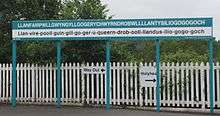
While probably most travelers visit destinations for other attractions than signs (and they are often not even considered attractions), they are still frequently objects of photography and part of the environment. Few foreign travelers would abstain from taking photos of the painted tile street name signs in Spain, iconic pub signs in Britain, kangaroo signs along Australia’s highways and the neon signs of Las Vegas and Chinatowns around the world.
The very first time you travel to a country where another alphabet is used, being surrounded by signs in a script you probably cannot make any sense of is likely one of the major factors that make the place feel exotic and even intimidating.
Types of signs
Road and street signs
Route signs along the former Route 66 are the obvious example of iconic road signs. Other famous routes, roads and hiking trails, also often have a special recognizable type of sign.
When crossing into another country, province or other area there may be a remarkable “welcome” sign or even kind of gate or "arch of triumph". Note that it may not be OK to take photos of or near border crossings, as these are regarded as sensitive security areas.
Abroad you may see not only traffic signs you haven’t seen before but new variants of familiar signs. For instance outside Europe and the US chances are that the text on the eight-sided red stop sign will be something else than “STOP”. Even in Latin America you will encounter “PARE” or “ALTO”.
Signs notifying of dangers that are not commonly found around the world like the polar bear signs on Svalbard are also worth a photo. Relatively unique prohibitive signs also belong in this category, like the crossed-out maté gourd on Uruguayan intercity buses or durian fruit in the Singapore MRT system (though photography is not allowed in the latter).
Cities and towns often have street signs that are aesthetically beautiful like the ones in the Vienna Old town or otherwise iconic. Moreover some streets and squares like Broadway or the Red Square are world famous, so while there don't forget to take a pic of the sign as well! Some famous streets (Champs Elysée in Paris, Unter den Linden in Berlin) are also marked by street signs that in some cases have become famous in their own right if only as "proof" that you actually were there, so take pictures.
Streets, squares and roads are often named after important historical persons, events or places. Interestingly, they may be named after persons still alive (countries with authoritarian regimes are almost guaranteed to have these). And rock fans will probably find AC/DC Lane in Melbourne and the Calle AC/DC in Leganés outside Madrid worth a visit.
Places

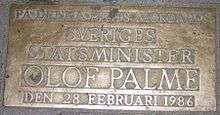
Whether it be places with funny names like Fucking or places famous for one reason or another like Wacken or Schengen, the entrance sign to the town has often become a common motive for photography. Signs for Hollywood and Las Vegas (see image) have even become attractions in their own right.
If a destination is rather small but has a funny or unusual name, road and street signs that include the place’s name are often among the main attractions. This also includes corresponding signs of businesses if such exist. Of course some destinations may have names that businesses prefer not to use.
Mountain peaks, particularly high or low locations, extreme points of countries, continents and such often have a sign informing people that they are at such a location. Also, places where important historical people have been born or events have taken place are often marked by a commemorative plaque.
Rail systems
- See also: rail enthusiast travel

Some major urban rail systems have very distinctive signs and logos, the best known probably being the Underground signs at the entrance to and inside the London Tube and the “Metropolitain” signs of Paris. Also, stations that are remarkably decorated often also feature remarkable station name signs.
If you travel on named train services, there are often signs on the stations or at least on and inside the wagons themselves. In addition, before and after an extraordinary train journey like the Trans-Siberian, do take photos of the station signs too.
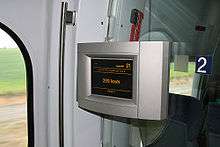
Most modern high speed rail systems have some display showing travel speed. If you are fortunate enough to catch the speedometer (in practice, unless you're allowed into the driver's compartment, info screen) when it shows 300 km/h, 200mph or even more, do take a picture. For some this may even be a factor or at least a contributing factor to chose a certain train in the first place.
Business signs
Old towns may have signs for businesses from the time where electrical light didn’t exist. Sometimes the establishment the sign marks may not be there any longer, sometimes it is, and otherwise the establishment isn't actually that old but just has an old-looking sign to better fit into the environment. These can be painted on the walls like murals or signboards mounted on or hanging out of the wall. In particular the British Isles are famous for their beautiful pub signs. Painted signboards such as the ones seen in Western movies can be seen in the ghost towns of the old west.
"Guild signs" (or modern replicas made to look like them) are another favorite. Often, they protrude into the street at a right angle to be better visible. Examples include a distinctive striped "barber pole" (or a pair of scissors) for barbers, a pretzel for bakers, animals for butchers or restaurants. They are often used to invoke (real or proclaimed) tradition going back centuries and a "down home" feeling of the "good old days".
The modern version of these are neon signs, that have been around for about a century. Invented in France, they are probably more often associated with the United States and subsequently East Asia and East Asian communities around the world. Actual neon signs used to be more common, but have partially been replaced by LED signs and screens.
Billboards and street advertisements can also be considered part of this category, however they are not as permanent as the other forms of signage.
In some cites (notably the City of London) you may also find older signs typically cast in metal with heraldic elements accompanied by numbers or letters These were originally signs to private fire brigades (run by insurance companies) that a particular building had paid its insurance premium and was thus under that brigade's protection.
Ancient signs
Signs are something that has likely been around as long as people have transmitted information through written text or pictures. For instance, at the time they were in use, ancient Greek temples often had inscriptions informing visitors of do’s and dont’s.
See
Destinations
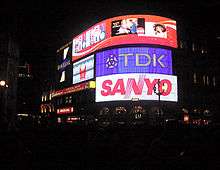
Some destinations in the world are famous for their signage:
- 🌍 Times Square — needs no further introduction
- 🌍 Piccadilly Circus — London's equivalent
- 🌍 Las Vegas in general, both the Strip and downtown
- 🌍 St.Pauli in Hamburg, as well as some other red light districts in the world. Also in St.Pauli you may spot some signs explicitly prohibiting guns; would you expect such signs elsewhere in Western Europe?
- 🌍 Kabukichō in Tokyo; or actually most major East Asian cities and East Asian ethnic enclaves.
- 🌍 Fucking is home to Austria's most stolen sign, together with pretty much any place with an unusual name
- Commercial districts in large cities of non-first-world countries. Although the mishmash of (often homemade) signs of all designs, shapes and sizes may not appeal to everyone, they're still a part of the street landscape there and "exotic". Especially if written in a language you don't understand or even script you cannot pronounce.
Museums
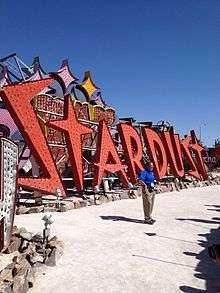
There are several museums around the world showcasing signs both neon signs and other kinds:
- 🌍 American Sign Museum, 1330 Monmouth St (Cincinnati, Camp Wasington off the Hopple Street Exit on I-75), ☎ +1 513 541-6366, e-mail: info@americansignmuseum.org. Wed – Sat 10AM – 4PM Sun 12:00 – 4PM. Check out the only museum dedicated to the sign industry and features a very large collection of signs from all around the United States. Covering nearly 100 years of sign making and advertising, the museum boasts an impressive collection of painted, light bulb, plastic, and of course neon signs. Guided tours are available at 11:00 am and 2pm during museum hours. The museum also houses Neon Works, the last full-time neon workshop in Cincinnati and is able to demonstrate their craft during weekday tours. $10-15.
- 🌍 Neon Museum, 770 N Las Vegas Blvd (Las Vegas), ☎ +1 702 387-6366. An outdoor lot loaded with huge signs that once twinkled in front of the Silver Slipper, Stardust, and El Cortez. See the giant horseshoe made of thousands of gold-colored light bulbs. Open only by one-hour guided tours. $18.
- 🌍 Neon Muzeum, Ul. Minska 25 (Warsaw/Praga). We-Su 12-17. Interested in the signage from the eastern side of the former Iron Curtain? This museum features Polish neon signs from the Cold War era and photos of them. PLN 10.
- 🌍 God's Own Junkyard, Unit 12, Ravenswood Industrial Estate, Shernhall Street (London/East). open Fr-Su only. A museum displaying hundreds of illuminated signs (neon and bulb signs) including signs of businesses, decorative signs, movie props and artworks.
- 🌍 Showa Neon Kanban Takamura Goro Museum, 1-7-17 Minami-Shinagawa (Tokyo/Shinagawa). The sign company Showa Neon has a museum with shop signs from the Edo and early Meiji periods. Reportedly all descriptions in this museum are in Japanese. free.
Buy
Truly iconic signs are often available as souvenirs, both as replica signs and as other forms. Consider buying one of those, if you want to bring home something physical.
Respect
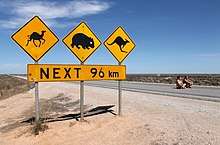
Especially street signs with unusual or funny names and animal signs such as moose and reindeer warnings in Sweden and Finland and kangaroo and other animal warnings in Australia are often subjects to theft by souvenir-hungry tourists. Don’t do this. Not only is it illegal, but if you are removing a warning sign someone may actually get injured or even die; see animal collisions. Yes, visitors to Fucking may just get annoyed that they cannot take a photo of a sign because it’s stolen, but imagine what a missing warning sign for a hairpin curve on a road, or lava or land mines next to a path in the worst case could cause!
Manipulation of signs to make a humorous or political statement, is usually illegal as well.
Depending on the type and age of the sign and the country it is located in, you may want to have a look at the Freedom of Panorama legislation of that country if you wish to publish a photo of the sign on the Internet or in some other form.
In the case of warning and prohibition signs, you should of course obey them. If you’re on a sign photo safari, do put your camera away if you see a “no photography” sign. And just like with urbex, don’t enter areas you are not allowed to.